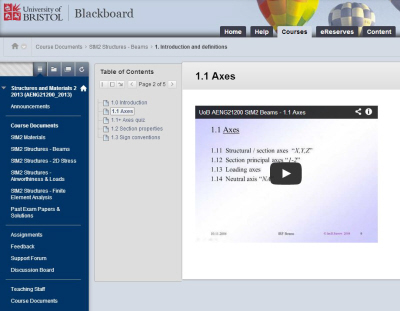Department of Aerospace Engineering, University of Bristol
Steve Bullock, Steve.Bullock@bristol.ac.uk
You can also pre-record lectures using Re/Play. Contact us if you would like to discuss this further.

“Flipping the classroom” has been defined as:
“students gain first exposure to new material outside of class, usually via reading or lecture videos, and then use class time to do the harder work of assimilating that knowledge, perhaps through problem-solving, discussion, or debates.” (Vanderbilt University Center for Teaching)
Steve was keen to make the most effective and efficient use of learning resources, including face-to-face contact time. He argues that lecturing can be an inefficient delivery method for some types of content. He wanted to allow students to engage with the lecture material at their own pace and was also keen to be able to identify more quickly areas that students had not understood, so he could pro-actively address these in a timely manner. He had seen the use of annotated video clips elsewhere including Khan Academy and MOOCs, and thought that this approach could work in the context of the unit on which he was teaching.
The existing Powerpoint slides used for the topic were excellent, so Steve did not need or want to re-create these. Instead he opted to record a narration and annotations over them.
Building on the existing high quality tried and tested slides, he recorded himself presenting and at times annotating the presentation. This was done in his office using Camtasia, a webcam with mic and a Wacom bamboo tablet and pen for the annotation. Once he was comfortable with the tools, he found that in an hour he could produce a 20 minute video, which represented the same amount of content as in a 50 minute lecture.
He also added a small amount of video of himself talking to help introduce and get students engaged with the approach. He uploaded the videos to YouTube and then made them available in Blackboard, using the Blackboard Learning Module tool to present them alongside other relevant materials in a structured way.
(The screen shot, above right, shows one of the videos within a Blackboard Learning Module. The Learning Modules included worked examples and occasional quiz questions to help check understanding.)
The face-to-face sessions were used to work through further examples, deal with questions in more detail and recap or reinforce areas which were not well understood.
Steve found Blackboard learning modules were very useful as a way of structuring presentation of the content.
By recording he found that he could improve delivery, for example making the presentation more concise by removing pauses. In some cases he found that a 50 minute lecture could be cut down to approximately 20 minutes of recording.
There was some very positive feedback from students who engaged with the approach, for example valuing the ability to repeat and go at their own pace. Comments included:
Even though Steve clearly explained that students would need to engage with the video material before the face-to-face sessions, some did not. He thinks this was largely due to the timing of the unit, which spans the semesters (weeks 7 - 14) and means that students have other important work during that time in preparation for exams. A few students felt that more time in the face-to-face sessions should have been used to cover material.
In future he would like to incorporate more measurement of online participation, add more diagnostic and formative tests which students do before the face-to-face sessions to help him pinpoint areas of weakness, and explore possible ways of increasing student accountability.
For others considering this approach he stresses that it involves a shift in the focus of your role as a lecturer, from an emphasis on content delivery to the facilitation of understanding, diagnosing problem areas and addressing these. It is also important to explain to students why you are using this approach and how it can benefit their learning. Four short videos from Professor Steven Hall, Massachusetts Institute of Technology, show how this can be approached.